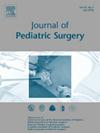小儿腹腔镜胆囊切除术的抗生素预防。
IF 2.4
2区 医学
Q1 PEDIATRICS
引用次数: 0
摘要
背景:外科感染学会(SIS)指南建议对接受择期腹腔镜胆囊切除术的低风险患者不使用外科抗生素预防(SAP):利用国家外科质量改进计划(NSQIP)数据,确定了在2021年至2022年期间接受腹腔镜胆囊切除术的5440名儿科患者。排除了免疫缺陷、活动性恶性肿瘤、美国麻醉医师协会(ASA)身体状况分类3-5级、有感染指征的手术、紧急手术、在预防窗口期前接受静脉注射抗生素或SAP数据缺失的患者:共有 3959 例患者纳入分析。在这些患者中,3570 人(90.2%)接受了 SAP 治疗。30 天内浅切口手术部位感染 (SSI)、深切口 SSI 和器官间隙 SSI 的总发生率分别为 0.9%、0.0% 和 0.1%。未接受 SAP 治疗的患者浅切口 SSI 发生率明显更高(SAP 0.8 %,无 SAP 2.1 %;P = 0.024)。未接受 SAP 治疗的患者器官间隙 SSI 的发生率也明显更高(未接受 SAP 治疗的患者为 0.1%,未接受 SAP 治疗的患者为 0.8%;P = 0.008)。C.diff结肠炎的发生率没有差异(接受 SAP治疗的为0.1%,未接受 SAP治疗的为0.0%;P = 1.000)。控制西班牙裔、年龄和性别的多变量模型显示,与未接受 SAP 的患者相比,接受 SAP 的患者术后发生 SSI 的几率明显降低(OR = 0.35):结论:对于接受择期腹腔镜胆囊切除术的低风险患者,医院目前并未遵守 SIS 指南中关于不使用抗生素预防的规定。鉴于上述发现,作者主张开展更多研究,并重新评估针对儿科患者的现行指南:研究类型:回顾性比较研究:证据等级:III。本文章由计算机程序翻译,如有差异,请以英文原文为准。
Antibiotic Prophylaxis for Elective Pediatric Laparoscopic Cholecystectomies
Background
The Surgical Infection Society (SIS) guidelines recommend against the use of surgical antibiotic prophylaxis (SAP) for low-risk patients undergoing elective laparoscopic cholecystectomies.
Methods
Using National Surgical Quality Improvement Program (NSQIP) data, 5440 pediatric patients were identified who underwent laparoscopic cholecystectomy from 2021 to 2022. Patients who had immunodeficiency, active malignancy, American Society of Anesthesiologists (ASA) physical status classification 3–5, procedure indicated for infection, emergent procedure, received intravenous antibiotics before the prophylaxis window, or missing SAP data were excluded.
Results
3959 patients were included in the analysis. Among these patients, 3570 (90.2 %) received SAP. Overall incidence of 30-day superficial incisional surgical site infection (SSI), deep incisional SSI, and organ space SSI were 0.9 %, 0.0 %, and 0.1 %, respectively. The incidence of superficial incisional SSI was significantly higher in the patients who did not receive SAP (SAP 0.8 %, no SAP 2.1 %; p = 0.024). The incidence of organ space SSI was also significantly higher in the patients who did not receive SAP (SAP 0.1 %, no SAP 0.8 %; p = 0.008). There was no difference in the incidence of C. diff colitis (SAP 0.1 %, no SAP 0.0 %; p = 1.000). Multivariable modeling, controlling for Hispanic ethnicity, age, and gender, demonstrated patients that received SAP were significantly less likely to have any postoperative SSI compared to patients who did not receive SAP (OR = 0.35).
Conclusion
Hospitals are not currently compliant with SIS guidelines regarding omission of antibiotic prophylaxis for low-risk patients undergoing elective laparoscopic cholecystectomies. The authors advocate for additional studies and reassessment of current guidelines for pediatric patients given the above findings.
Type of Study
Retrospective comparative study.
Level of Evidence
III.
求助全文
通过发布文献求助,成功后即可免费获取论文全文。
去求助
来源期刊
CiteScore
1.10
自引率
12.50%
发文量
569
审稿时长
38 days
期刊介绍:
The journal presents original contributions as well as a complete international abstracts section and other special departments to provide the most current source of information and references in pediatric surgery. The journal is based on the need to improve the surgical care of infants and children, not only through advances in physiology, pathology and surgical techniques, but also by attention to the unique emotional and physical needs of the young patient.

 求助内容:
求助内容: 应助结果提醒方式:
应助结果提醒方式:


